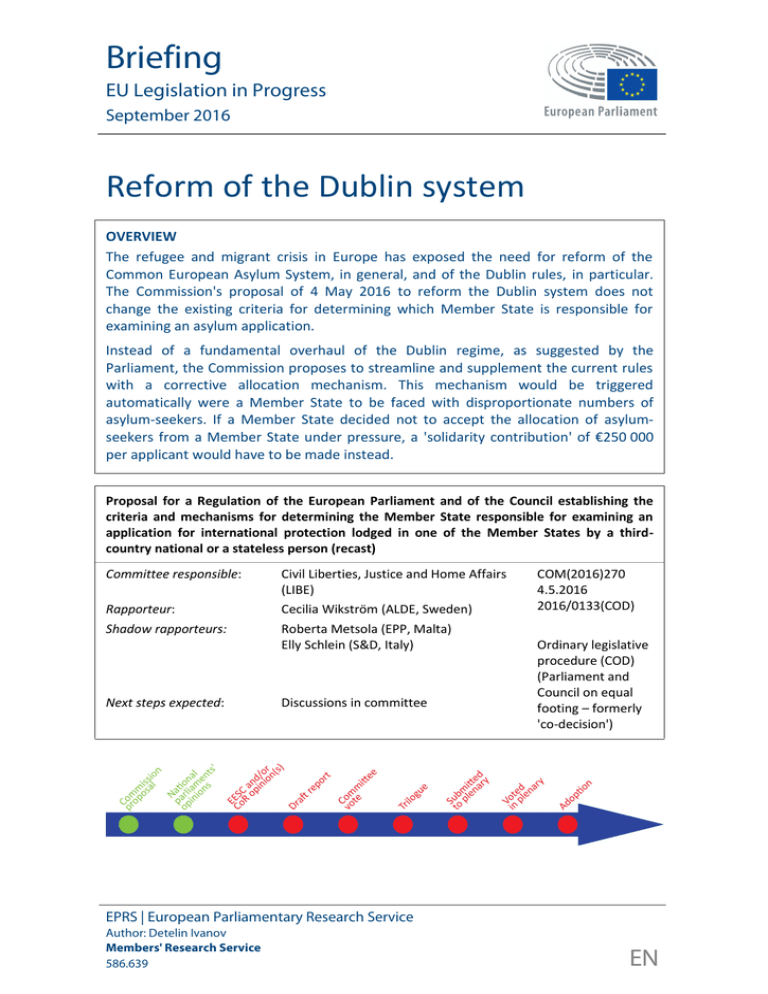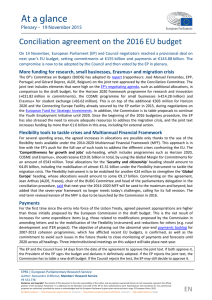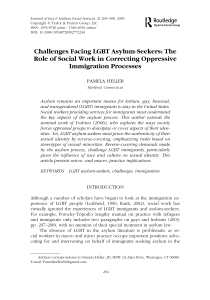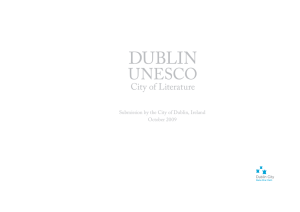Reform of the Dublin system - European Parliament
Anuncio

Briefing EU Legislation in Progress September 2016 Reform of the Dublin system OVERVIEW The refugee and migrant crisis in Europe has exposed the need for reform of the Common European Asylum System, in general, and of the Dublin rules, in particular. The Commission's proposal of 4 May 2016 to reform the Dublin system does not change the existing criteria for determining which Member State is responsible for examining an asylum application. Instead of a fundamental overhaul of the Dublin regime, as suggested by the Parliament, the Commission proposes to streamline and supplement the current rules with a corrective allocation mechanism. This mechanism would be triggered automatically were a Member State to be faced with disproportionate numbers of asylum-seekers. If a Member State decided not to accept the allocation of asylumseekers from a Member State under pressure, a 'solidarity contribution' of €250 000 per applicant would have to be made instead. Proposal for a Regulation of the European Parliament and of the Council establishing the criteria and mechanisms for determining the Member State responsible for examining an application for international protection lodged in one of the Member States by a thirdcountry national or a stateless person (recast) Committee responsible: Rapporteur: Shadow rapporteurs: Next steps expected: Civil Liberties, Justice and Home Affairs (LIBE) Cecilia Wikström (ALDE, Sweden) Roberta Metsola (EPP, Malta) Elly Schlein (S&D, Italy) Discussions in committee COM(2016)270 4.5.2016 2016/0133(COD) Ordinary legislative procedure (COD) (Parliament and Council on equal footing – formerly 'co-decision') EPRS | European Parliamentary Research Service Author: Detelin Ivanov Members' Research Service 586.639 EN EPRS Reform of the Dublin system Introduction Recent unprecedented migratory pressure on Europe has exposed the need to reform the Common European Asylum System (CEAS), in general, and the Dublin rules, in particular, as well as to secure greater solidarity and a fairer sharing of responsibility between Member States. Context Europe is currently confronted with the worst refugee and migration crisis since the Second World War. Pushed by violence and poverty in the Middle East and North Africa, and pulled by the prospect of safety and a better life in Europe, more than 1.3 million asylum seekers and economic migrants sought refuge in the EU in 2015. According to Frontex, 1.83 million illegal border crossings were detected at the EU's external borders in 2015, compared with 283 500 in 2014. According to the UN Refugee Agency (UNHCR), 1 015 078 migrants reached Europe by crossing the Mediterranean Sea, while 3 771 migrants were reported dead or missing in 2015. Greece witnessed 856 723 arrivals by sea from Turkey, and Italy saw 153 842 sea arrivals from North Africa. According to Eurostat, 1 321 600 asylum applications were registered in the EU in 2015, compared with 626 960 in 2014 and 431 090 in 2013. In absolute values, the EU Member States to receive the highest number of asylum-seekers in 2015 were Germany (476 510), Hungary (177 135), Sweden (162 450), Austria (88 160), and Italy (84 085). However, in proportion to their population (asylum-seekers per 100 000 nationals), the EU countries most affected in 2015 were Hungary (1 797), Sweden (1 667), Austria (1 028), Finland (591) and Germany (587). As regards migrants' countries of origin, the majority of asylum-seekers in the EU in 2015 came from Syria (368 400), Afghanistan (181 360), Iraq (124 905), Kosovo (72 465), Albania (67 740), Pakistan (47 840), Eritrea (34 105), Nigeria (31 165), Iran (26 550), and Ukraine (22 050). Existing situation The Dublin regime was originally established by the Dublin Convention signed in Dublin, Ireland, on 15 June 1990. In 2003, the Dublin Convention was replaced by the Dublin II Regulation. In 2013, the Dublin III Regulation was adopted, replacing the Dublin II Regulation. The Dublin III Regulation has been in force since 1 January 2014. The Dublin system was never designed to achieve solidarity and the fair sharing of responsibility; its main purpose from the very beginning was to assign responsibility for processing an asylum application to a single Member State. The Dublin III Regulation identifies the EU country responsible for examining an asylum application, by using a hierarchy of criteria such as family unity, possession of residence documents or visas, irregular entry or stay, and visa-waived entry. In practice, however, the most frequently applied criterion is the irregular entry, meaning that the Member State through which the asylum-seeker first entered the EU is responsible for examining his or her asylum claim. The current migration and refugee crisis has revealed significant structural weaknesses in the design and implementation of the CEAS and of the Dublin regime. This has been confirmed by recent external studies on the Dublin system and acknowledged by the Commission in its communication of 6 April 2016. Members' Research Service Page 2 of 8 EPRS Reform of the Dublin system Parliament's starting position Since 2009, the Parliament has consistently been calling for a binding mechanism for the fair distribution of asylum-seekers among all EU Member States (see EP resolutions of 25 November 2009, 11 September 2012, 9 October 2013, 23 October 2013, 17 December 2014, 29 April 2015, and 10 September 2015). On 9 September 2015, the Parliament supported the Commission's proposal of 27 May 2015 for a Council Decision on the relocation of 40 000 asylum-seekers from Italy and Greece. And on 17 September 2015, the Parliament backed the Commission's proposal of 9 September 2015 for a Council Decision on the relocation of 120 000 people in clear need of international protection. In its resolution of 12 April 2016 on the situation in the Mediterranean and the need for a holistic EU approach to migration, the Parliament made clear its position on the reform of the Dublin system: The criterion that it is the Member State of first entry that is responsible for the examination of a claim for international protection should be revised. One option for a fundamental overhaul of the Dublin system would be to establish a central collection of applications at Union level – viewing each asylum-seeker as someone seeking asylum in the Union as a whole and not in an individual Member State – and to establish a central system for the allocation of responsibility for anyone seeking asylum in the Union. Such a system could provide for certain thresholds per Member State relative to the number of arrivals, which could conceivably help in deterring secondary movements, as all Member States would be fully involved in the centralised system and no longer have individual responsibility for allocation of applicants to other Member States. Such a system could function on the basis of a number of Union 'hotspots' from where Union distribution should take place. Any new system for allocation of responsibility must incorporate the key concepts of family unity and the best interests of the child. On 11 May 2016, the Parliament held an initial debate on the Commission's proposals to reform the CEAS. MEPs pointed out that the Dublin rules were not working and must be replaced with an efficient asylum system, based on solidarity among Member States. Many MEPs had wanted to see a more ambitious proposal and doubted whether the proposed redistribution scheme would work. They also criticised the fact that Member States would be able to avoid taking in asylum-seekers in return for making a financial contribution. Some stressed Member States' right to self-determination and criticised the plan to ask them to contribute financially if they do not accept refugees. On 13 June 2016, the LIBE Committee held a hearing on the impact of recent migration flows on the implementation and revision of the CEAS. Council and European Council starting position In 2015, the Council adopted two decisions on the emergency relocation of people in clear need of international protection from Italy and Greece to other Member States, on the basis of Article 78(3) of the Treaty on the Functioning of the European Union (TFEU) and as a temporary derogation from the Dublin III Regulation. On 14 September 2015, the Council adopted, by a unanimous vote, a decision for the relocation of 40 000 asylum‐seekers from Italy and Greece to other Member States Members' Research Service Page 3 of 8 EPRS Reform of the Dublin system (Decision (EU) 2015/1523). On 22 September 2015, the Council adopted, by a qualified majority vote – with Slovakia, the Czech Republic, Romania and Hungary voting against, and Finland abstaining – a decision for the relocation of another 120 000 asylum‐seekers from Italy and Greece to other Member States (Decision (EU) 2015/1601). Member States' starting position Both Slovakia, on 2 December 2015 (Case C-643/15), and Hungary, on 3 December 2015 (Case C-647/15), filed lawsuits with the Court of Justice of the European Union (CJEU), asking the Court to annul the second relocation decision (Decision (EU) 2015/1601). Some legal experts have expressed doubts as to the likelihood that Slovakia and Hungary will win their cases before the CJEU.1 On 15 February 2016, the Prime Ministers of the Visegrad Group countries (Czech Republic, Hungary, Poland, and Slovakia) gathered at an extraordinary summit to discuss the migration crisis. In their Joint Statement on Migration, they expressed their full support for measures adopted at EU level with the aim of more effective protection of the external borders, while repeating their negative stance on an automatic permanent relocation mechanism. Preparation of the proposal In 2015, the Commission asked an external consultancy (ICF International) to prepare two studies: an Evaluation of the Implementation of the Dublin III Regulation and an Evaluation of the Dublin III Regulation. These exposed a number of shortcomings in the design and implementation of the Dublin system. In addition to the external evaluation, the Commission undertook targeted consultations with the coordinators of the political groups on the European Parliament's Committee on Civil Liberties, Justice and Home Affairs, with Member States and with other stakeholders. The changes the proposal would bring While keeping unchanged the existing criteria for determining which EU country is responsible for examining an asylum application, the Commission proposes to streamline and supplement the Dublin system with a corrective allocation mechanism (the so-called 'fairness mechanism'). The main elements of the proposal are: a new automated system to monitor the number of asylum applications received and the number of persons effectively resettled by each Member State; a reference key to determine when a Member State is under disproportionate asylum pressure; and a fairness mechanism to address and alleviate that pressure. Automated registration and monitoring system The development of a new automated registration and monitoring system is proposed. It would consist of a central system, a national interface in each Member State, and communication infrastructure between the central system and the national interface. The automated system would record each asylum application made in the EU as well as the number of people each Member State effectively resettles. The central system would be run by a new proposed European Union Agency for Asylum. Members' Research Service Page 4 of 8 EPRS Reform of the Dublin system Determination of a Member State being under disproportionate asylum pressure A reference key is proposed to show the indicative share of the total number of asylum applications made in the EU that each Member State would receive if they were allocated according to a country's size and wealth. This reference key would be based on two criteria with equal weighting: the size of the population, and the total gross domestic product (GDP) of a Member State. Comparing the reference share to the actual distribution of asylum claims would help determine when one Member State is responsible for a disproportionate amount of asylum applications compared with other Member States. Resettlements would be included under the number of asylum applications, to acknowledge the importance of efforts to implement legal and safe pathways to Europe. Fairness mechanism It is proposed that a fairness mechanism be applied when Member States are confronted with a disproportionate number of asylum applications. If the number of asylum applications made in a Member State is above 150% of the reference share, the fairness mechanism will be automatically triggered. All new asylum applications made after the triggering of the mechanism will be relocated across the EU. If a Member State decides not to accept the allocation of asylum applicants from a Member State under pressure, a 'solidarity contribution' of €250 000 per applicant would have to be made. New arrivals to Member States benefiting from the fairness mechanism will be relocated across the EU until the number of applications falls back below 150% of the country's reference share. Budgetary implications According to the Commission, the financial resources necessary to support implementation of this proposal would total €1 828.6 million for the 2017-2020 period. The Commission asserts that these financial needs are compatible with the current multiannual financial framework. Preliminary analysis The Commission's proposal was analysed in a June 2016 study on The Reform of the Dublin III Regulation, commissioned by EP Policy Department C at the request of the LIBE Committee. Francesco Maiani, the author of the study, argues that, by retaining the Dublin philosophy and relying on more coercion, the Commission's proposal is unlikely to achieve its objectives, while raising human rights concerns. He advocates re-centring EU responsibility-allocation schemes on one key objective – quick access to asylum procedures. This would require taking protection-seekers' preferences seriously and de-bureaucratising the process. According to him, such a reform would need to be accompanied by (a) stepping up the enforcement of refugee rights across the EU, (b) moving solidarity schemes from a logic of capacity-building to one of compensation, and (c) granting protected persons real mobility rights. Members' Research Service Page 5 of 8 EPRS Reform of the Dublin system Advisory committees In its opinion of 10 December 2015 on the European Agenda on Migration, the European Economic and Social Committee (EESC) pointed out that there is a need for a permanent, fair and binding system of burden-sharing, whereby those seeking protection are allocated between all EU countries. This must be supported by a permanent distribution key based on a number of considerations. The preferences of the asylum-seeker should also be taken into account as long as they are linked with considerations that would facilitate integration. In its opinion of 3 December 2015 on the European Agenda on Migration, the Committee of the Regions (CoR) welcomed the Commission's commitment to submit proposals amending the Dublin Regulation, under which asylum could be requested and examined outside the EU. It called on the Commission to ensure that the distribution of responsibility between Member States is based on sustainable criteria and that the fundamental rights of migrants are respected. This must be underpinned by an EU-wide mandatory distribution key for sharing asylum-seekers between the Member States. Both Committees are working on opinions on the present proposal, with a view to adopting them before the end of 2016. National parliaments No Member State parliament had submitted a reasoned opinion on the proposal by the eight-week deadline for submission. Stakeholders' views This section aims to provide a flavour of the debate and is not intended to be an exhaustive account of all different views on the proposal. Additional information can be found in related publications listed under ‘EP supporting analysis’. ECRE The European Council on Refugees and Exiles (ECRE) is concerned that the Commission's proposal includes a number of modifications that seem to contradict the case law of the Court of Justice of the European Union (CJEU). According to ECRE, the principle that unaccompanied children are to be transferred to the first country in which they applied for asylum goes against the MA judgment of the CJEU, which found that, given their particular vulnerabilities, 'as a rule, unaccompanied minors should not be transferred'. ECRE also argues that sanctions such as withdrawal of material reception conditions from those who engage in secondary movements are in conflict with the CIMADE and GISTI ruling of the CJEU. UNHCR In its paper of 3 March 2016 'Stabilizing the situation of refugees and migrants in Europe', the UN Refugee Agency (UNHCR) proposed the development of reinforced European systems for the registration and distribution of asylum-seekers, with the establishment of European Registration Centres (ERCs) in the main countries of arrival. Asylum-seekers would be distributed among the Member States according to a distribution key setting out the percentage of asylum-seekers each Member State must take. There would be no quota or upper limit. Factors such as family links, work or study in a Member State, or knowledge of a language would be taken into account. Members' Research Service Page 6 of 8 EPRS Reform of the Dublin system Public opinion The Parliament's Parlemeter 2015 survey was conducted in all 28 EU Member States between 19 and 29 September 2015. According to this survey, most Europeans favoured a common global approach to migration policy, both in terms of decision making at EU level (66% approval) and with regard to priority financial support for the Member States bearing the brunt of immigration (62%); they also favoured a legal migration procedure that would be the same in all Member States (79% approval). With regard to the distribution of asylum-seekers among the EU Member States, nearly 8 out of 10 respondents (78%) thought that the number of asylum-seekers should be better distributed among all the Member States. Within that group, 75% thought the distribution of asylum-seekers should be determined at EU level on the basis of binding quotas. In several Member States, however, that view was far from enjoying majority support. Academic views The view that some of the changes proposed by the Commission seem to violate the case law of the CJEU and the EU Charter of Fundamental Rights is shared by academics such as Steve Peers and Constantin Hruschka. In addition to the concerns raised by the ECRE, both academics point out that the Commission's proposal limits the scope of the right to appeal of asylum-seekers and therefore risks breaching the right to an effective remedy under the EU Charter of Fundamental Rights. Legislative process The Commission adopted its proposal COM(2016) 270 final on 4 May 2016. The proposal would recast the Dublin III Regulation and should be adopted on the same legal basis, namely Article 78, second paragraph, point (e) of the TFEU, in accordance with the ordinary legislative procedure. The proposal has been assigned to the Civil Liberties, Justice and Home Affairs Committee (LIBE), with Cecilia Wikström (ALDE, Sweden) appointed as rapporteur. Her draft report is expected to be presented in the autumn. Opinions are also to be provided by the Budgets Committee (BUDG) and the Legal Affairs Committee (JURI). EP supporting analysis Malmersjo G., Remáč M., Regulation 604/2013 (Dublin Regulation) and asylum procedures in Europe: Implementation Appraisal, EPRS, PE 573.304 (2016). Maiani F., The Reform of the Dublin III Regulation, EP Policy Department C, PE 571.360 (2016). Wagner M., Baumgartner P., Dimitriadi A., O'Donnell R., Kraler A., Perumadan J., Schlotzhauer J., Simic I., Yabasun D., The Implementation of the Common European Asylum System, EP Policy Department C, PE 556.953 (2016). Neville D., Sy S., Rigon A., On the frontline: the hotspot approach to managing migration, EP Policy Department C, PE 556.942 (2016). Members' Research Service Page 7 of 8 EPRS Reform of the Dublin system Guild E., Costello C., Garlick M., Moreno Lax V., Carrera S. Enhancing the Common European Asylum System and Alternatives to Dublin, EP Policy Department C, PE 519.234 (2015). Guild E., Costello C., Garlick M., Moreno Lax V., Mouzorakis M., Carrera S. New Approaches, Alternative Avenues and Means of Access to Asylum Procedures for Persons Seeking International Protection, EP Policy Department C, PE 509.989 (2014). Thielemann E., Williams R., Boswell C., What System of Burden-Sharing between Member States for the Reception of Asylum Seekers?, EP Policy Department C, PE 419.620 (2010). Other sources Criteria and mechanisms for determining the Member State responsible for examining an application for international protection lodged in one of the Member States by a third-country national or a stateless person. Recast, European Parliament Legislative Observatory (OEIL), 2016/0133(COD). Endnote 1 Peers S., Relocation of Asylum-Seekers in the EU: Law and Policy, 24 September 2015; Groenendijk K., Nagy B., Hungary's appeal against relocation to the CJEU: upfront attack or rear guard battle?, 16 December 2015; Vikarska Z., The Slovak Challenge to the Asylum-Seekers' Relocation Decision: A Balancing Act, 29 December 2015. Disclaimer and Copyright The content of this document is the sole responsibility of the author and any opinions expressed therein do not necessarily represent the official position of the European Parliament. It is addressed to the Members and staff of the EP for their parliamentary work. Reproduction and translation for noncommercial purposes are authorised, provided the source is acknowledged and the European Parliament is given prior notice and sent a copy. © European Union, 2016. [email protected] http://www.eprs.ep.parl.union.eu (intranet) http://www.europarl.europa.eu/thinktank (internet) http://epthinktank.eu (blog) First edition. The ‘EU Legislation in Progress’ briefings are updated at key stages throughout the legislative procedure. Members' Research Service Page 8 of 8





